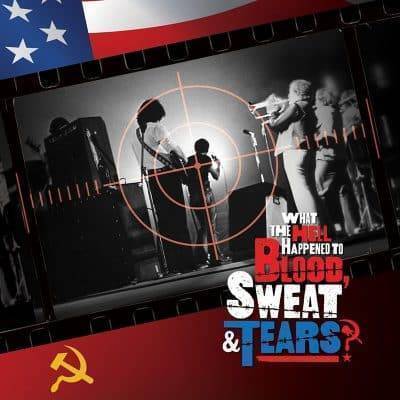Blood, Sweat, & Tears What the Hell Happened to Blood, Sweat & Tears?
 Blood, Sweat, & Tears
Blood, Sweat, & Tears
What the Hell Happened to Blood, Sweat & Tears? – Original Soundtrack
Omnivore
Now that we think about the question posed in the album title, it’s one that many of us have pondered, or in most cases, probably forgot about in the intervening years. Yet, those who lived through the brief era of Blood, Sweat, & Tears immense popularity remain curious and are likely anxious to the see the film of which this CD release, What the Hell Happened to Blood, Sweat & Tears, is the soundtrack. The film is a political thriller with a classic rock band (more specifically pioneering jazz-rock band) as the subject. This story has been suppressed for over 50 years. Although you won’t gain much insight from listening to this music, you’ll pick up a bit of information in the liner notes (and herein) that may encourage you to see the film or at least relive a bit of nostalgia. The band as atop the charts in 1970, arguably the most popular band on radio at the time, propelled by three major hits, versions of which are included on the soundtrack – (“You’ve Made Me So Very Happy,” “Spinning Wheel” and “And When I Die”).
As an aside, just as the British Invasion bands such as The Rolling Stones, The Yardbirds, The Blues Breakers, Cream and Led Zeppelin led many of us to seek out the original blues masters, the pioneering jazz-rock groups Blood, Sweat & Tears, Chicago, and Dreams led many of us into the world of jazz for the first time. To this day, the inaugural BS&T album, Child Is Father to the Man, helmed by Al Kooper, remains a classic. You’ll learn that drummer Bobby Colomby and guitarist Steve Katz, group co-leaders, had wanted a “better” lead vocalist and recruited David Clayton Thomas while encouraging Kooper to stay on as composer, arranger, and keyboardist. Kooper, of course, left and the group turned more toward a pop direction with amazing commercial results.
The album, really their second but first with lead vocalist David Clayton Thomas, had been nominated for four Grammy® awards, ultimately winning two, including Album of the Year (over The Beatles’ Abbey Road), and sales passed the 4 million mark domestically. The band was touring to sold-out audiences around the world and had just completed their third album (and as it turned out, final) in the studio.
In 1970, Blood, Sweat & Tears became the first American rock band to perform behind the Iron Curtain, doing concerts in Yugoslavia, Romania, and Poland. The tour was sponsored by the U.S. State Department. A documentary film crew accompanied the band and shot over 65 hours of material for what was intended to be a theatrical documentary. The documentary was never released, and the film footage disappeared. The music was also captured on tape but never issued or even heard by the band themselves. Upon returning to the states after the tour, the group became victim to the divisive politics and culture wars that were polarizing America. (Sounds familiar, right?) When you visit the band’s website – www.bloodsweatandtears.com, (yes, they remain touring with Colomby as the only original member) you’ll learn that Katz claims they were victims of blackmail, in accepting the tour. The film director says this, “It was absolutely fascinating to me that Blood, Sweat & Tears were victims of cancel culture long before we began using this phrase. Political criticism usually comes from one side or the other. But in a unique set of circumstances, BS&T was hammered by the right and the left. Even more stunning, we learned that the band figured into geo-political discussions at the Nixon White House and at the highest levels of government in three Communist countries.”
The film about this tour, this journey and the discovery of the film and music that documented one of the world’s biggest bands at the peak of their powers. Award winning director John Scheinfeld (Who Is Harry Nilsson (And Why Is Everybody Talkin’ About Him?), The U.S. vs. John Lennon, Chasing Trane: The John Coltrane Documentary) has once again unveiled a thrilling story that contains never-before-seen film footage and stunning musical performances. It also features interviews with five of the nine band members including David Clayton-Thomas, saxophonist/flutist and musical arranger Fred Lipsius, innovative bass player Jim Fielder, outspoken guitarist Steve Katz and drummer and band leader Bobby Colomby. The other members represented on the soundtrack are Dick Halligan (organ, trombone), Jerry Hyman (trombone), Lew Soloff (trumpet), and Chuck Winfield (trumpet). Okay, this writer has checked the original album and can assure you that they are indeed the roster from that legendary second album, simply entitled Blood, Sweat, & Tears.
The soundtrack album features ten previously unheard performances from the 1970 Iron Curtain Tour including “Hi De Ho” from their then-yet-released third album (Blood, Sweat & Tears 3). Interestingly, David Clayton Thomas sings Kooper’s “I Can’t Quit Her” as the encore. Produced and curated by the band’s founding member Bobby Colomby, the sound quality, while not pristine, is certainly decent. Packaging includes liner notes from Scheinfeld and Colomby and photos from various members of the band.
Omnivore Recordings is also presenting the digital-only release of What The Hell Happened To Blood, Sweat & Tears? – Original Score, composed by founding member Bobby Colomby and arranger/composer/musician David Mann. What makes this release incredibly unique is the original score is not only co-written by original member Colomby, but performed by the current 2023 lineup of Blood, Sweat & Tears, bringing the musical vibe right up to date.
You can watch the soundtrack and score trailer, Like you, the film has the interest of this writer, too.
- Jim Hynes
Buy Us a Cup of Coffee!
Join the movement in supporting Making a Scene, the premier independent resource for both emerging musicians and the dedicated fans who champion them.
We showcase this vibrant community that celebrates the raw talent and creative spirit driving the music industry forward. From insightful articles and in-depth interviews to exclusive content and insider tips, Making a Scene empowers artists to thrive and fans to discover their next favorite sound.
Together, let’s amplify the voices of independent musicians and forge unforgettable connections through the power of music
Make a one-time donation
Make a monthly donation
Make a yearly donation
Buy us a cup of Coffee!
Or enter a custom amount
Your contribution is appreciated.
Your contribution is appreciated.
Your contribution is appreciated.
DonateDonate monthlyDonate yearlyYou can donate directly through Paypal!
Subscribe to Our Newsletter
Order the New Book From Making a Scene
Breaking Chains – Navigating the Decentralized Music Industry
Breaking Chains is a groundbreaking guide for independent musicians ready to take control of their careers in the rapidly evolving world of decentralized music. From blockchain-powered royalties to NFTs, DAOs, and smart contracts, this book breaks down complex Web3 concepts into practical strategies that help artists earn more, connect directly with fans, and retain creative freedom. With real-world examples, platform recommendations, and step-by-step guidance, it empowers musicians to bypass traditional gatekeepers and build sustainable careers on their own terms.
More than just a tech manual, Breaking Chains explores the bigger picture—how decentralization can rebuild the music industry’s middle class, strengthen local economies, and transform fans into stakeholders in an artist’s journey. Whether you’re an emerging musician, a veteran indie artist, or a curious fan of the next music revolution, this book is your roadmap to the future of fair, transparent, and community-driven music.
Get your Limited Edition Signed and Numbered (Only 50 copies Available) Free Shipping Included
Discover more from Making A Scene!
Subscribe to get the latest posts sent to your email.









